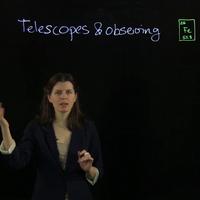Ep. 10: Telescopes and Observing
Have you ever wondered how all the chemical elements are made?
Then join me as we are lifting all the star dust secrets to understand the cosmic origin of the chemical elements.
Astronomers collect data and when you want to work with the oldest stars and
you want to determine their cosmic chemical composition, you have to use the
technique of spectroscopy.
Spectroscopy means that we split up the light into the
rainbow colors and because we are looking for stars with very weak absorption
lines in the very end, we need to stretch out the light real bad
to get to a data quality level that is sufficient for our work. Now, if you
want to split up your light over so many colors, you really need a big glass, a big
telescope, in order to collect enough light that there is enough light, a
photons, left over for every single color in the rainbow. I use the Magellan
telescope in Chile. It has a 6.5 meter mirror and it's a beautiful telescope
and like going observing very much. But most people really can't
understand what it means when I say I go observing. Well, what it means is I fly
to Chile, the telescope is located in the Atacama Desert 2500 meters up, and one
has to fly to Santiago first and then to La Serena and then, from there, it's two
hours with a car up into the mountains, and then when you get there you see the
mountains, you see a little telescope glistening in the Sun. Actually, there are
two telescopes there, they are twin telescopes. I use mostly just one of them,
sometimes I use the other one too, and one time, actually, I used them both. That
was exciting -- both at the same time! I had to run back and forth between the two to
make sure that everything is working properly. What you have when you
get there is that you have a beautiful mountain landscape and of course at night you
have the beautiful dark sky above you. The stars are so bright all together
when they make up the Milky Way that, actually, I used to walk outside and I
didn't need to bring a flashlight. There was no moon but the Milky Way band
in the Southern hemisphere is so bright that you can just walk outside. You
wouldn't run into a tree or a car or whatever. And I could almost imagine that
I would see the shadow from the Milky Way's light. I could have just imagined
that but the fact that I, actually, was in this position that I said, like, "Oh, can I
see my shadow from the night sky?" that's just fantastic in itself.
In the following, I want to show you a few videos that I have taken at
the telescopes to give you a little insight into what it means, what this
observing means, and how we collect data. But I also want to share with you what
the night sky looks like because it is just too beautiful and words really
can't describe it.

